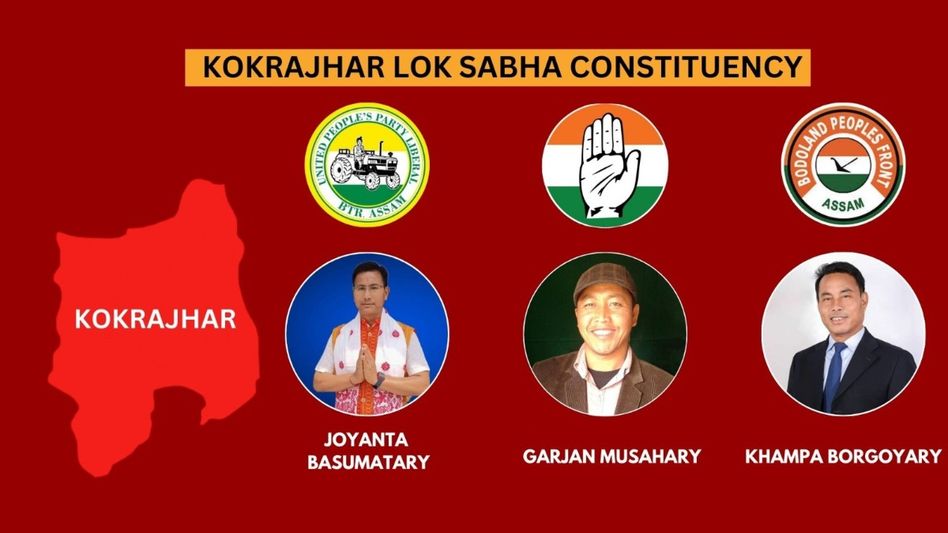Kokrajhar Lok Sabha Constituency - Know your candidates, population, polling percentage, last election results
The Kokrajhar Lok Sabha constituency in Assam has emerged as a significant political battleground, characterized by its unique demographic and historical electoral patterns. Predominantly inhabited by the Bodo community, the politics of Kokrajhar has been traditionally shaped by the dynamics between the Bodo and non-Bodo communities.

The Kokrajhar Lok Sabha constituency in Assam has emerged as a significant political battleground, characterized by its unique demographic and historical electoral patterns. Predominantly inhabited by the Bodo community, the politics of Kokrajhar has been traditionally shaped by the dynamics between the Bodo and non-Bodo communities.
The electoral history of Kokrajhar reveals interesting trends, notably the absence of an anti-incumbency wave. Candidates who secure victory once tend to maintain their stronghold over the constituency for multiple terms. For instance, from 1957 to 1971, D Basumatary of the Congress party clinched victory in four consecutive elections. Similarly, Sansuma Khungur Bwiswmuthiary secured three consecutive wins from 1998 to 2004. This trend underscores the significance of incumbency advantage in Kokrajhar's electoral dynamics.
A notable phenomenon in Kokrajhar's electoral landscape is the emergence of independent candidates who have challenged established political parties. In 2014 and 2019, Naba Kumar Sarania, an independent candidate, secured victories, significantly disrupting traditional party equations. Sarania's victories underscore the electorate's willingness to transcend party affiliations in favor of candidates perceived as independent voices.
The demographic composition of Kokrajhar constituency plays a crucial role in shaping electoral outcomes. With a population of over 1.4 million, comprising a balanced male-female ratio, the constituency reflects the diversity of Assam's demographic landscape. The presence of a significant Bodo population underscores the community's political influence, while the participation of non-Bodo communities adds complexity to the electoral calculus.
Kokrajhar constituency is divided into nine assembly segments, each representing distinct socio-political dynamics. In the 2019 General Assembly Elections, the constituency witnessed a commendable 83.16% voter turnout, indicative of the electorate's active engagement with the democratic process. The high voter turnout underscores the significance of Kokrajhar in the broader political narrative of Assam.
Notably, this Lok Sabha election Joyanta Basumatary has been fielded as NDA candidate from Kokrajhar, while Congress has fielded Garjan Musahary. The Bodoland People's Front has fielded Khampa Borgoyary as their party candidate.
Meanwhile Naba Kumar Sarania, who has been consecutively winning the Kokrajhar seat in the past general elections as an independent candidate had faced a setback recently when his caste certificate was termed as 'fake'. But in the latest development Guwahati High Court has overturned the state government's speaking order, paving the way for Naba Kumar Sarania, an Independent Member of Parliament from Assam, to contest from the Kokrajhar constituency in the upcoming Lok Sabha elections
As the Kokrajhar Lok Sabha Constituency Election 2024 approaches, the political landscape is poised for another intense battle. Scheduled for May 7 (Phase 3), the elections are expected to witness fierce competition among various contenders vying for electoral supremacy. The presence of 1862 polling stations, with Sidli-Chirang (ST) constituency having the highest number, underscores the logistical complexities of conducting elections in a geographically diverse constituency.
The Kokrajhar Lok Sabha constituency in Assam encapsulates the complexities of Indian democracy, characterized by its unique demographic composition, historical electoral patterns, and emerging trends. As the constituency gears up for the upcoming elections, all eyes will be on the candidates and parties vying for victory, with the electorate poised to make its voice heard on June 4th, when the results are announced.
Copyright©2024 Living Media India Limited. For reprint rights: Syndications Today









